The Toshiba OCZ VX500 (256GB, 512GB, 1024GB) SSD Review
by Billy Tallis on September 13, 2016 9:00 AM ESTSequential Read Performance
The sequential read test requests 128kB blocks and tests queue depths ranging from 1 to 32. The queue depth is doubled every three minutes, for a total test duration of 18 minutes. The test spans the entire drive, and the drive is filled before the test begins. The primary score we report is an average of performances at queue depths 1, 2 and 4, as client usage typically consists mostly of low queue depth operations.
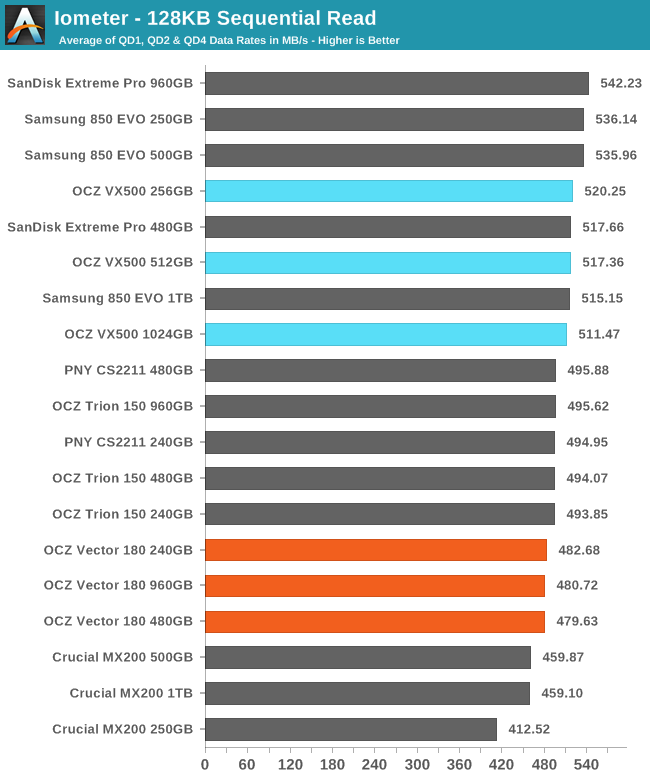
The VX500 delivers very good sequential read performance, in the same league as the Samsung 850 EVO and SanDisk Extreme Pro. Because the spread of scores on this test is so small, this only represents a slight improvement over the Vector 180.
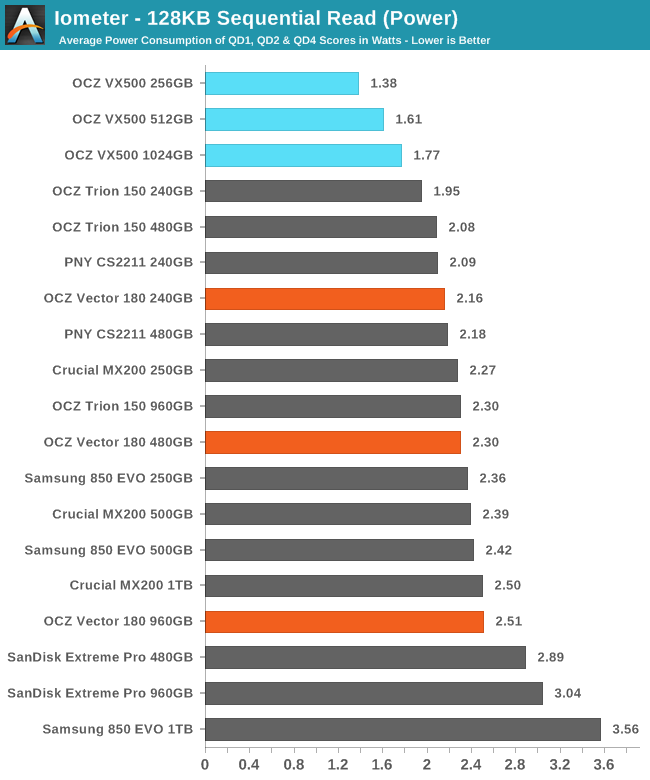
Power consumption is quite a bit lower than the competition and efficiency is again near record levels.
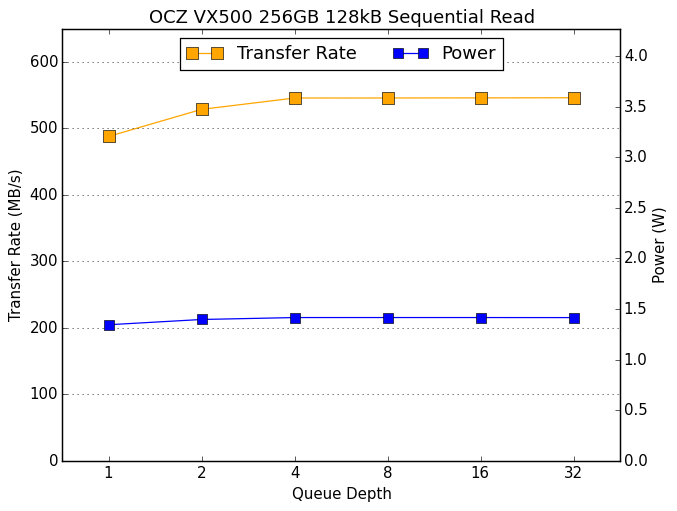 |
|||||||||
The VX500 starts out with very good QD1 performance and very little room for improvement. It reaches the limit of the SATA interface by QD4, and power consumption is nearly constant across the whole test.
Sequential Write Performance
The sequential write test writes 128kB blocks and tests queue depths ranging from 1 to 32. The queue depth is doubled every three minutes, for a total test duration of 18 minutes. The test spans the entire drive, and the drive is filled before the test begins. The primary score we report is an average of performances at queue depths 1, 2 and 4, as client usage typically consists mostly of low queue depth operations.
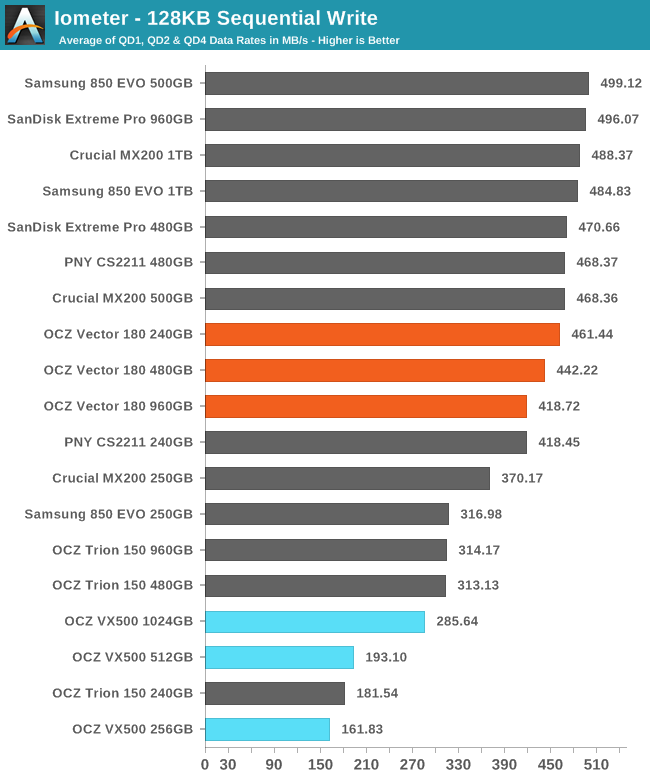
The OCZ VX500 fares very poorly on this test. The drive is filled before the test is run, and apparently the VX500 did not finish flushing the SLC cache before the performance measurement began. These numbers thus represent the worst-case write performance for the VX500, while some TLC SSDs will continue to degrade under a longer write load.
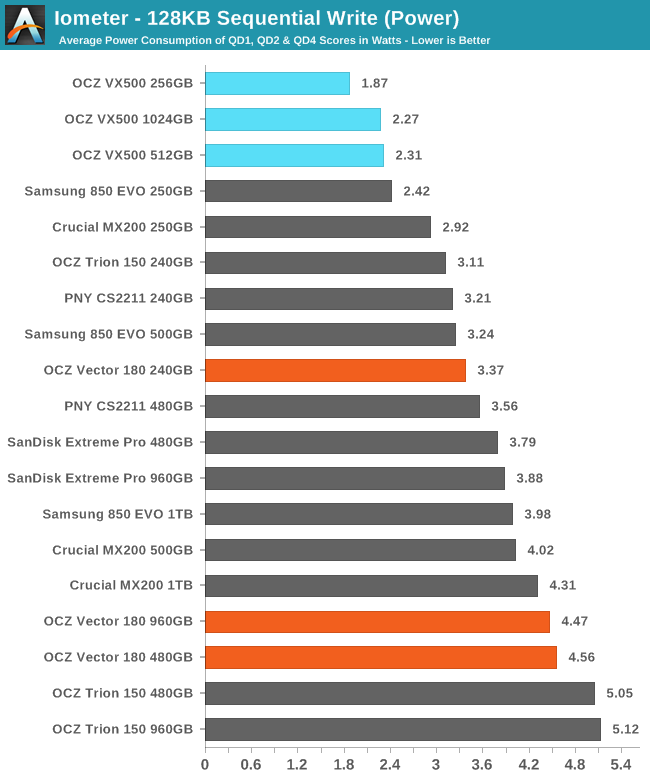
In spite of the extra background work during this test as the VX500 copes with an already full SLC cache, it maintains very low power consumption. Efficiency is still a regression relative to the Vector 180 for the smaller two sizes, but the 1TB model manages a slight improvement.
 |
|||||||||
Most drives exhibit little or no scaling with queue depth, and the smaller two VX500s follow this pattern. The above plot of the 1TB model's behavior looks very odd, but an inspection of the second-by-second performance data (below) reveals that it it periodically escaping from the low-performance state and delivering write speeds near the limit of the SATA interface. On a shorter test with less data written beforehand, the smaller models would likely also have shown their good side for some or all of the test.


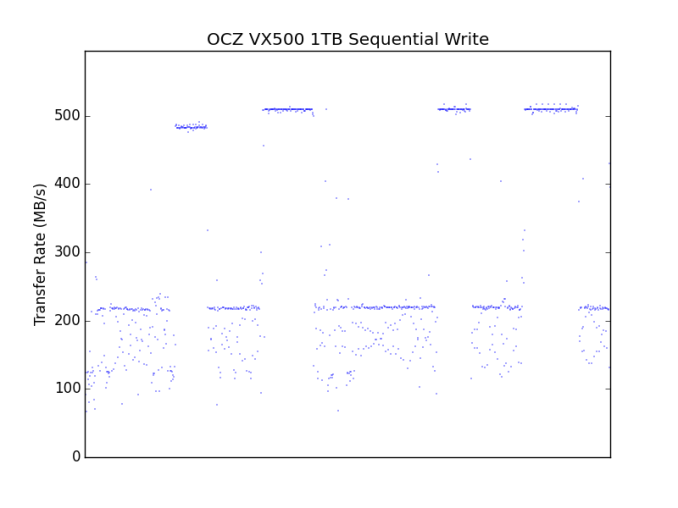








29 Comments
View All Comments
Lolimaster - Tuesday, September 13, 2016 - link
LOL $337? You can get 1TB and 1 500GB Crucial MX500 with just a few more bucks.Lolimaster - Tuesday, September 13, 2016 - link
MX3002016, still no edit button, GG.
sonicmerlin - Tuesday, September 13, 2016 - link
Feels like SSD prices/GB have been pretty stagnant the last couple years.rhysiam - Wednesday, September 14, 2016 - link
They have dropped significantly. Check out the price table from the 850EVO launch review which was less than two years ago. Cheapest $/GB drive was the 240GB ARC 100 @ 42c/GB. That table in this article has a bunch of drives cheaper than that, and it's mid-range SATA drives. There are entry level 480GB drives going today that are only $10 more than the budget 240GB drives from less than two years ago.I'd call that pretty reasonable progress on the $/GB front.
rhysiam - Wednesday, September 14, 2016 - link
Here's the table from the 850EVO launch review: http://www.anandtech.com/show/8747/samsung-ssd-850...sonicmerlin - Wednesday, September 14, 2016 - link
The EVO was always higher priced. Look at the average prices:https://pcpartpicker.com/trends/price/internal-har...
They've come down, but not as dramatically as before. I remember well over a year ago being able to buy a SDD for 25 cents/GB on a good deal, and now it's about 20 cents/GB. Perhaps it's because of the slow transition to 3D NAND, but I'm hoping the pace picks up again.
Hiniberus - Wednesday, September 21, 2016 - link
When will these go on sale? I'm curious about them but I can't find any store that has them in stock!superunknown98 - Friday, September 23, 2016 - link
I don't really understand the final words giving the drive praise. It didn't seem to perform that much better compared other drives, including it's predecessor. Even in ATSB-Destroyer it had middling performance with good power consumption.cargostud - Thursday, February 2, 2017 - link
I had a VTR1-25SAT3-512G with a 5 year Warranty. It has 4k Random Write: 95K IOPS; 4k Random Read: 100K IOPS according to the specs. It died a few weeks ago and it is being replaced with a VX500. It has a spec of 4k Random Write: 64K IOPS; 4k Random Read: 92K IOPS. The replacement drive is slower than the one I had before. Wouldn't a more fair replacement be a VT180? 4k Random Write: 90K IOPS; 4k Random Read: 90K IOPS